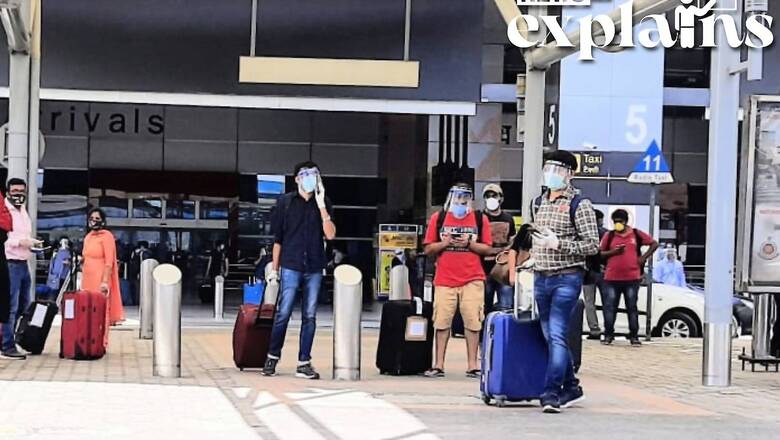
views
From today, all international flights from China, Singapore, Hong Kong, the Republic of Korea, Thailand, and Japan will require a pre-departure RT-PCR negative test report.
Airlines are directed to modify their check-in functionalities to incorporate the changes, and to issue boarding passes only to international passengers travelling from these five countries who have submitted self-declaration forms on the Air Suvidha portal, beginning January 1, 2023.
The New Guidelines
On December 30, the Ministry of Civil Aviation issued revised Covid guidelines for passengers arriving in international flights. RT-PCR testing should have been completed 72 hours before embarking on the journey.
The current practise of randomly testing 2% of arriving passengers on each international flight will be maintained. These decisions were made in response to an increase in coronavirus infections around the world, as well as reports of the spread of SARS-CoV-2 variants in these five countries.
The ministry sent the revised guidelines communication to all scheduled commercial airlines, airport operators, and chief secretaries/administrators of states/Union Territories, among others, on Friday.
World Health Organization (WHO) Director-General Tedros Adhanom Ghebreyesus has stated that the global body is concerned about the evolving situation in China, where Covid-19 infections have seen a new surge since curbs were relaxed.
What is the Situation in China
China has been seeing a resurgence of Covid-19, after the country relaxed its strict lockdown norms under Xi Jinping’s ‘Zero Covid’ policy. The move has necessitated travel curbs from incoming travellers from China in many countries.
China on its part has criticised the countermeasures taken by various countries including the US, Japan and India requiring travellers from China to undergo the required tests.
Official Covid-19 figures from China have become unreliable as less testing is being done across the country following the recent easing of the “zero-COVID” policy.
Beijing’s decision to lift all travel restrictions, including scrapping of quarantine for inbound travellers from January 8 ahead of Chinese New Year, has caused alarm around the world.
Millions of Chinese are expected to travel to various parts of the world for holiday during this period.
European Nations Tighten Curbs
France, Spain and England have also implemented tougher Covid-19 measures for passengers arriving from China, the Associated Press reported. France’s government is requiring negative tests, and is urging French citizens to avoid nonessential travel to China. France is also reintroducing mask requirements on flights from China to France.
French health authorities will carry out random PCR tests at airports on passengers arriving from China to identify potential new coronavirus variants. The new rules take effect on Sunday, but officials said it would be a few days before they are fully in place.
The U.K. government announced that anyone traveling to England on direct flights from China would be required to take a pre-departure test from Jan. 5.
Health Secretary Steve Barclay said that the U.K. was taking a “balanced and precautionary approach.” He described the measures as “temporary” while officials assess COVID-19 statistics.
France and Spain said they would continue to push for a Europe-wide policy.
France’s hospitals have struggled in recent weeks with a large number of patients because of three concurrent outbreaks: the seasonal flu, a wave of bronchitis cases and COVID-19.
Earlier, Spain’s government said it would require all air passengers coming from China to have negative tests or proof of vaccination. The United States announced new COVID-19 testing requirements Wednesday for travelers from China, joining some Asian nations that had imposed restrictions. Japan on Friday started requiring tests for passengers arriving from China.
WHAT HAPPENED IN CHINA?
China was relying on the Zero Covid approach all this while to deal with the pandemic.
In contrast to other countries, which have accepted that they will have to live with the disease to some extent, China was pursuing a policy known as “dynamic zero,” which entails taking dynamic action wherever Covid-19 flares up in order to eradicate it.
The Chinese government claimed that this policy saves lives because uncontrolled outbreaks endanger many vulnerable people, such as the elderly.
But due to this factor, a large majority of the Chinese population was never exposed to the virus like other countries, leading to low levels of immunity – because of low levels of infection so far.
After country-wide anti government and lockdown protests in China, Xi Jinping began relaxing lockdown, putting an end to Zero Covid.
However, as predicted, this has led to a spurt in infections and hospitalisations, and even reported deaths.
When it comes to China, the country’s vaccination rate is above 90%, but the rate for boostered adults drops to 57.9%, and to 42.3% for people aged 80 and above, according to government data.
In September, an article by a publication under the Chinese Center for Disease Control and Prevention (CDC) acknowledged coverage of older adults was poor, and that the absence of local doctors in vaccine drives, poor medical understanding and a lack of insurance for potential side effects all dampened enthusiasm.
“It’s a very special case in China because people felt very safe for a long time,” said Stephanie Jean-Tsang, an assistant professor at Hong Kong Baptist University who specialises in messaging around health.
Authorities have not made vaccination mandatory amid signs that the public would push back against any such move. Last week China said it would start to offer a second booster – or fourth shot – for high-risk groups and people over 60 years old.
Overseas-developed vaccines are unavailable in mainland China to the general public, which has relied on inactivated shots by Sinopharm, Sinovac’s Coronavac and other domestically developed options for its vaccine rollout and which the medical community has found to be safe. It has also yet to introduce its own version of an mRNA vaccine.
While China’s medical community in general doesn’t doubt the safety of China’s vaccines, questions remain over their efficacy compared to foreign-made mRNA counterparts, said Kelly Lei, a doctor in the southern Chinese city of Shenzhen.
In late November, the hashtag ‘Sinovac vaccine counterfeit’ surged to five million views on the Twitter-like Weibo platform, with many posts discussing lumps and hair loss allegedly caused by the locally made vaccine.
“At least a half of doctors and educated people wanted to get the mRNA ones and refused to get the Chinese ones,” Lei said.
“After a while, people see no hope and also they are kind of forced to get the Chinese ones, so they had to accept it. Some doctors talked to me, and said it’s useless anyway, why waste the money.”
Lei said many of her friends are looking to visit the neighbouring Chinese territory of Macau, where mainlanders can receive mRNA vaccines.
Demand has surged in recent weeks, visitors to Macau say, with the online booking platform for vaccination showing no bookings available until Jan. 21.
There is also the problem of vaccine hesitancy in China.
Early reluctance to get vaccinated was due to initial uncertainty about safety outcomes in older people, which stemmed in part from a lack of clinical trials assessing the outcomes of domestic vaccines in this age group.
In some cases, physicians who advised older patients with chronic conditions against vaccination shared this reluctance.
With inputs from Reuters
Read all the Latest Explainers here



















Comments
0 comment